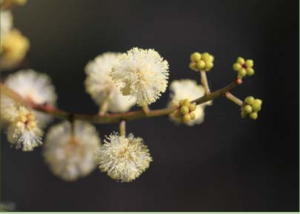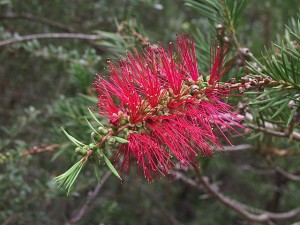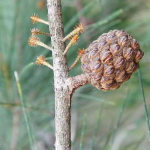
Sunshine wattle – photo: Michael Fiedler
The days are getting shorter and cooler, but there are still delights to look out for in the bush, including flowers and seed that you can use to propagate your own plants.
Right now you may notice the first of the wattles flowering, Acacia terminalis (Sunshine wattle) with lemon yellow flower heads on sparse bushes about person height, and Corymbia maculata (Spotted Gum) with creamy white staminous flowers. Both of these occur naturally towards the coastal fringe.

Twin-flowered tea-tree – photo: J Miles & M Campbell
Seed collecting is not as busy as in summer and autumn, but there are still some species worth noting. Many of the riparian plants have seed capsules which mature in winter. Leptospermum emarginatum (twin-flowered tea-tree) is a favourite with larger foliage (than you expect on a tea-tree) and 2 or more flowers per leaf axil.

River bottlebrush – photo: Miles & Campbell
Callistemon subulatus (river bottlebrush) tends to blend in to the surroundings until the stunning red-crimson flower spikes open, when it is easy to spot. You can then collect the older capsules containing seed.
Casuarinas are another good species to collect seed from over winter, including the river she-oak (Casuarina cunninghamiana) and the black/forest she-oak (Allocasuarina littoralis).

Cone of Allocasuarina littoralis – photo: Fiedler
Once you’ve collected your capsules or cones, place them in a paper bag in a warm, dry place, label them and wait for them to open and release their seeds. You can then store them in a cool place in an airtight, vermin-proof container ready for your next propagation project.
So head out for a winter walk and see what you can find!



